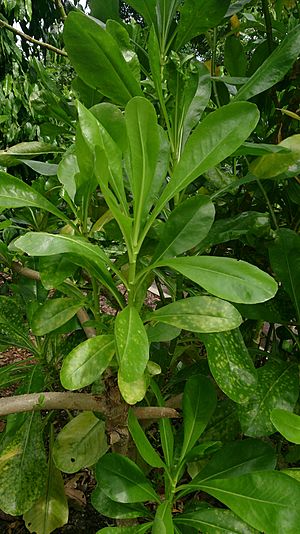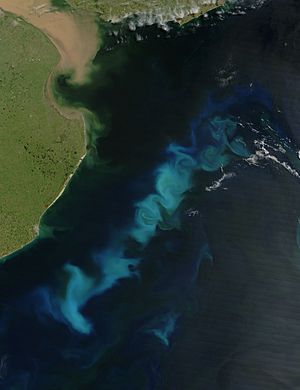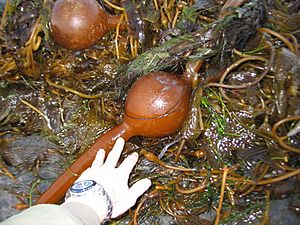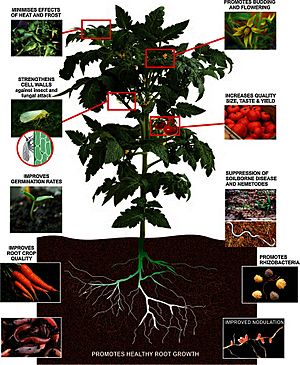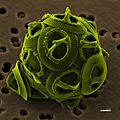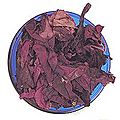Algae facts for kids
Algae are simple, plant-like living things that can make their own food using sunlight. This process is called photosynthesis. When you talk about one, it's an "alga," but many are "algae." The study of algae is known as phycology.
Algae are a very diverse group. They all share one main thing: they are autotrophic. This means they create their own food from natural energy sources and simple materials. Unlike land plants, they don't have complex structures like leaves or roots. For a long time, scientists grouped many different organisms under "algae." But now we know how different they truly are. There are about 72,500 known types of algae around the world!
Contents
What are Algae?
Algae are a huge and varied group of simple living things that usually make their own food. Some algae are made of just one cell, while others have many cells. The biggest and most complex algae found in the ocean are called seaweeds. They look a bit like plants but are considered "simple" because they don't have the special organs that land plants do, like roots, stems, and leaves. Because of this, they are not classified as true plants.
In older books, tiny living things called Cyanobacteria (also known as "blue-green algae") were sometimes called algae. However, scientists now know that true algae are eukaryotic organisms. This means their cells have a special center called a nucleus and tiny parts called chloroplasts, both enclosed in membranes.
It's important to know that algae are not all from the same single ancestor. This means they are not a monophyletic group, even though they share some features.
Almost all algae have parts that perform photosynthesis and produce oxygen. Some tiny, single-celled types might get energy from other sources too, with less or no photosynthesis. Scientists believe the first land plants probably grew from freshwater algae nearly 500 million years ago. Fossils of algae have been found that are as old as 1.6 to 1.7 billion years!
Where Algae Live
Algae in Nature
You can usually find algae in wet places or in water. They are common on land and in water. On land, algae are often hard to see and are much more common in moist, tropical areas than in dry ones. Algae don't have special tissues like land plants to help them live in dry places. However, they can survive dryness by living together with a fungus in a partnership called a lichen.
Different kinds of algae play very important roles in water environments. Tiny algae that float in water are called phytoplankton. They are the main food source for most marine food chains, feeding everything from tiny creatures to huge whales.
Kelp is a type of large seaweed that mostly grows in shallow ocean waters. Some kelp is eaten by people or collected to make products like agar or fertilizer. Kelp can grow in huge groups called kelp forests. These forests help protect coastlines from wave damage. Many different species live in kelp forests, including sea urchins, sea otters, and abalone.
Sometimes, algae can cause problems for other living things. If too many algae grow at once, it's called an algal bloom. These blooms can sometimes produce harmful toxins that can kill fish in the water. For example, some algae called Dinoflagellates can turn fish flesh into a slimy liquid, which the algae then eat.
Algae Partnerships
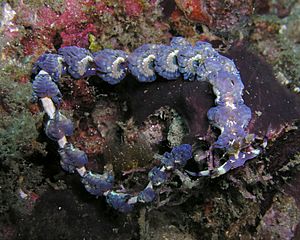
Algae have developed many special partnerships, called symbiosis, with other organisms. The most famous example is the lichen, which looks like a plant but is actually a partnership between a fungus and an alga. This partnership is very successful, and there are twenty thousand known types of lichens!
Less known are the partnerships between algae and animals. Reef-building corals are tiny animals called polyps that live in groups. Corals need light because the algae living inside them are important partners. These corals have even developed shapes, often like trees, to give the algae the most light possible.
The coral helps the algae by weakening their cell walls and then eating about 80% of the food the algae make. In return, the coral's waste provides nutrients for the algae. So, like with lichens, both partners benefit. The algae in corals are usually golden-brown flagellate algae. A unique thing about this partnership is that corals might push out their algae during tough times, and then get them back later. When corals lose their algae, it's called bleaching because the coral loses its color.
Other types of animals like sea anemones and jellyfish also have algae living inside them. Jellyfish with algae will move to places where their algae partners can get the best light during the day. At night, they might go deeper into the water where there are more nutrients.
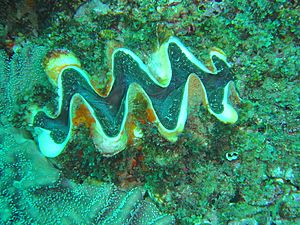
Sea slugs and clams are also known for having algae. Both of these animals are molluscs. Sea slugs that eat coral often have the same color as the coral they graze on. They can separate the algae from the coral tissues they eat. The algae cells then move to the slug's tentacles, where they continue to live. This helps the slug by giving it both camouflage and food.
The giant clam keeps algae in its mantle, which is the soft part of its body that you see when the clam is open. The colorful mantle has clear spots that act like lenses, focusing light onto the algae underneath. When there are too many algae, the clam digests some of them.
Many other marine invertebrates, like Flatworms and Polychaete worms, also have symbiotic relationships with algae.
How We Use Algae
Today, people use algae in many ways. For example, they are used as fertilizers for plants, to improve soil conditioners, and as food for farm animals. Tiny algae and algae that live in water are grown in clear tanks or ponds. They can be harvested or used to clean up liquid waste that flows through the ponds. Growing algae on a large scale is an important type of aquaculture (water farming) in some places. A type of red algae called Maerl is often used to improve soil.
Naturally growing seaweeds are an important food source, especially in Asia. They provide many vitamins like A, B1, B2, B6, niacin, and C. They are also rich in important minerals such as iodine, potassium, iron, magnesium, and calcium.
Also, tiny algae grown for commercial use are sold as healthy supplements. Examples include spirulina, Chlorella, and a vitamin-C supplement from Dunaliella, which is high in beta-carotene. In recent years, algae have become a popular source of omega-3 fatty acids for vegetarians. Carrageenan, which comes from the red alga Chondrus crispus, is used to make milk products thicker and more stable.
Algae are national foods in many countries. China eats more than 70 types, including fat choy, which is seen as a vegetable. Japan uses over 20 types, such as nori and aonori. In Wales, Laver is used to make "laver bread." In Korea, they use gim. Algae are also eaten along the west coast of North America, from California to British Columbia, in Hawaii, and by the Māori people of New Zealand. Sea lettuce and badderlocks are used in salads in Scotland, Ireland, Greenland, and Iceland. Scientists are even looking at algae as a possible way to help solve the problem of world hunger.
Different types of polymers (materials made of repeating units) can be created from algae. These can be very useful for making bio-plastics. Several companies have started to make algae polymers for things like flip-flops and surfboards.
Images for kids
-
A false-color image from a scanning electron micrograph of the tiny, single-celled Gephyrocapsa oceanica.
-
The kelp forest exhibit at the Monterey Bay Aquarium, showing a large, multi-celled kelp plant.
-
Algae growing on coastal rocks at Shihtiping in Taiwan.
-
Phytoplankton in Lake Chūzenji.
See also
 In Spanish: Alga para niños
In Spanish: Alga para niños


